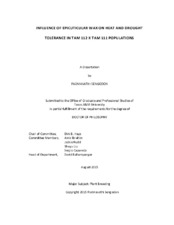| dc.description.abstract | High temperature and drought are the major constraints to wheat production globally. However, plants cope with stress by manipulating their physiological processes. This study investigates the role of leaf and glume wax content in reducing canopy temperature and quality stability in TAM 111 x TAM 112. A population of 124 recombinant inbred lines (RILs), derived from TAM 111 and TAM 112 was grown in greenhouse and multiple field locations across Texas for two years. The RIL showed variation for leaf wax and other physio-morphological traits indicating there is transgressive segregation for the traits. In this study, leaf wax didn’t show any association with neither conductance nor fluorescence. In our field study, epicuticular wax showed positive as well as negative association with yield and yield components suggesting need for further research. In addition, QTL were detected in chromosomes 1B, 2B, 3A, 3B, 3D, 4A, 4B, 4D, 5A, 5B, 6A, 6B, 6D, 7A, 7B and 7D. Among the 98 QTL, 18 loci across 10 chromosomes were associated with leaf epicuticular wax. For glume wax 14 QTL were identified with QTL explaining 7.6 to 13.6% variation. Yield and yield components QTL were found across the chromosomes. In addition, the RILs were analyzed for quality traits across locations. The protein content was negatively associated with yield parameters and mixograph peak time. Genotypic data was analyzed for co-localization between quantitative trait loci (QTL) regulating quality traits. QTLs were detected in all A, B and D genome. However, chromosome region of 7D followed by 1D had the most of the QTLs for traits including protein, peak time, hardness, kernel diameter, kernel weight, test weight, yield and wax. The QTL identified for some quality traits were consistent and stable across environments and could be useful in development of cultivars. | en |


